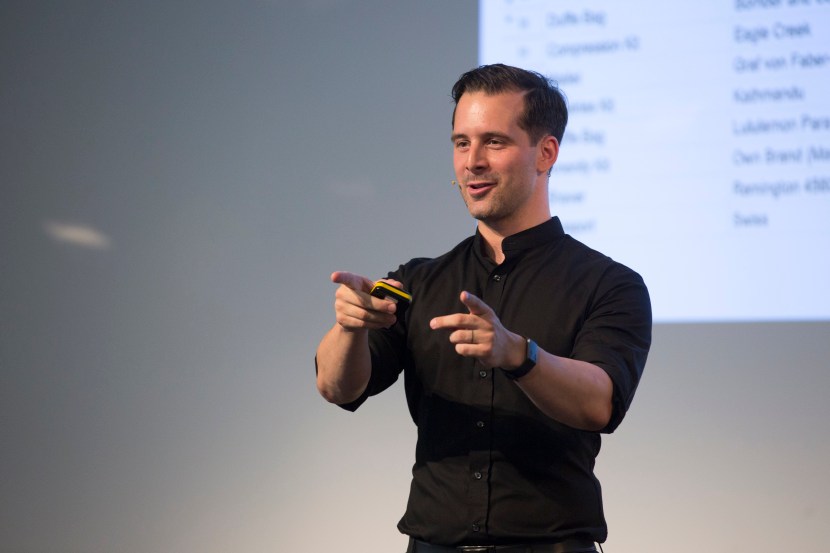Do you own your things, or do they own you?
 Contributed by Cédric Waldburger, an Entrepreneurs’ Organization (EO) member based in Zurich, Switzerland, and the founder and CEO of Tomahawk VC, which provides the resources and tools early-stage entrepreneurs need to shape the future of FinTech and DeFi. He lived without a home with just 64 things in his backpack for over three years. We asked Cédric how he went about minimizing his possessions to free his focus on his passions. Here’s what he shared:
Contributed by Cédric Waldburger, an Entrepreneurs’ Organization (EO) member based in Zurich, Switzerland, and the founder and CEO of Tomahawk VC, which provides the resources and tools early-stage entrepreneurs need to shape the future of FinTech and DeFi. He lived without a home with just 64 things in his backpack for over three years. We asked Cédric how he went about minimizing his possessions to free his focus on his passions. Here’s what he shared:
Essentialism—an offshoot of minimalism–is the focus on quality over quantity. It’s the art and practice of deliberately saying no to distractions and minimizing possessions so that you can focus on what truly matters to you. For entrepreneurs and business leaders, it’s about eliminating distractions so you can focus on what is essential for you to achieve your goals and pursue your passion.
I embraced essentialism several years ago so that I could better focus on my entrepreneurial career. The freedom I gained from living with so few possessions helped me prioritize my focus, increase decision-making capacity and enhance entrepreneurial agility to fully concentrate on the early-stage ventures I was guiding in different countries.
People often tell me they could never live with so few things, but essentialism isn’t about counting the number of items you have—it’s about what you gain in resources, time, energy and focus.
4 Steps to minimizing your possessions
Are you ready to try it? Much like knowing your passion is the first step to understanding what distracts you from it, when it comes to minimizing your possessions, it starts with increasing your awareness and challenging your actual needs against the things you believe satisfy them. The end result is having things that you know you’ll make use of and will therefore be serving you rather than vice versa.
Lay it all out
As the saying goes, awareness of a problem is the first step in solving it. That’s why, like any good engineer, I started by listing everything I owned into a spreadsheet. Laying it out on your bed works fine, too, but you run the risk of everything ending up on the floor after you procrastinate and suddenly realize it’s midnight. Becoming conscious of just how much you own is a humbling and important first exercise. In my case, the list wasn’t something I could just put together overnight because I had belongings that were unaccounted for–an extra pair of jeans at my parents’ home “ just in case” and a random pair of dress shoes my friend borrowed. Being patient with myself in creating the list was the best way I could increase my consciousness and therefore ensure that this would be a successful minimizing with no sock left uncounted.
90-90 Test
Next, for every single one of the items on your list (or on your bed), ask yourself, “Have I used this in the last 90 days, and will I need it in the next 90?” I apply this 90-90 principle because, together, it adds up to half a year. Chances are that such a time frame is long enough to be involved in formal events, colder and warmer weather, and give you a good idea of what you’ll need on a daily basis. If you don’t need it for 180 days, maybe you don’t need it at all, or if you need it only once, perhaps it’s something you could rent or borrow.
Corner it
A lot of things hold sentimental value, and it can be challenging to get rid of them. That’s why after items failed the 90-90 mental test and I realized they were not essential, I collected everything in a bag and put it somewhere out of sight and out of mind. Since I was living without a home, I left my bag at a friend’s house, but an attic or corner will work fine, too. Putting things aside creates a mental comfort bridge for getting rid of them permanently because you have the option to go back and grab something should you realize you miss it or need it. Personally, I never found the urge to go back.
Gift it
Ripping the Band-Aid off and finally giving your things away is certainly made easier when you recognize the potential value your dust collector has for someone else. Ask yourself, “Does someone need this more than I do?” and embrace the good feeling of gifting! For especially hard-to-get-rid-of items, visualizing someone else being excited to use it and getting a lot of miles from that item helped me over the tipping point. Alternatively, selling some of your possessions could open up possibilities for investments that would be more meaningful to you and your purpose.
Ah, freedom
Minimizing and the challenge of doing so made me realize how much the phrase “What if…?” surrounded the hesitation to let go. We interpret our belongings as a security blanket when in reality, it’s a trap and our possessions take over our own interests. So I urge you to ask yourself, “Do you own your things, or do they own you?”
Categories: Best Practices Inspirational WORK-LIFE INTEGRATION

